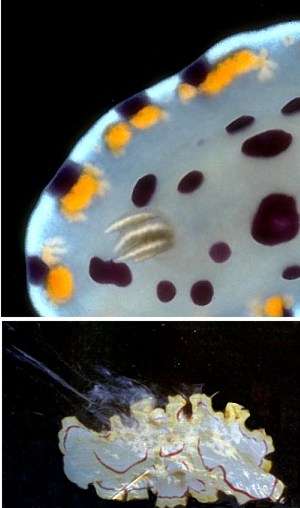Defensive Glands in Hypselodoris
May 21, 1999
From: Austin
Dear Bill,
And now for my continuing passion over Hypselodoris slugs.
Concerning Hypselodoris webbi and H. villafranca, the Avila et. al. (1991) paper suggests that the yellow-colored mantle dermal formations (MDF) where defensive allomones are concentrated, are located along the yellow border of the mantle so as to be camouflaged from would-be predators. Is there such a common trend from your observations that MDFs generally are the same color as body color markings? Or could this simply be a case of "fortuitous" overlap with the body color region? It seems more plausible that MDF location is more under selection for location (i.e. near important body parts like the gills and rhinophores) rather than color.
How do sea slugs produce mucus and where is it secreted? [ I'm thinking of the observation that the two Hypselodoris nudibranchs secrete a white mucus full of ichthyodeterrent furanosesquiterpenoids Avila et al., 1991).]
Thanks, Austin
jaustin@bio.fsu.edu
Austin, J, 1999 (May 21) Defensive Glands in Hypselodoris. [Message in] Sea Slug Forum. Australian Museum, Sydney. Available from http://www.seaslugforum.net/find/723
Dear Austin,
Sorry its taken me a while to answer this question. I guess you are referring to: Avila,C; Cimino,G; Fontana,A; Gavagnin,M; Ortea,JC; Trivellone,E (1991): Defensive strategy of two Hypselodoris nudibranchs from Italian and Spanish coasts. J. Chem. Ecol. 17(3), 625-636.
I am not sure if they were implying that the colour border was to hide the glands. In many chromodorids the glands become part of the colour pattern. For example in Chromodoris tumulifera the glands form a distinctive part of the colour pattern, especially in juveniles. I have put a close-up photo of the mantle edge of Chromodoris tumulifera alongside. In another example, Chromodoris woodwardae the white glands form a distinctive band at the mantle edge.
I discuss the role of these glands and colour patterns in defence on the Colour Defence, Defensive Glands and Chromodorid mimicry Pages.
If these animals are using their colour patterns to warn potential predators of their distastefulness, then it doesn't really matter if the glands are hidden or highly visible. The aim is to deter the predators. To hide the glands so the predator only knows about them after it takes a bite might give the prey a warm feeling of revenge (if it could think) but it would also give it a nasty pain in the side!
I think you are right in suggesting location is important. I suspect the position of the glands around the mantle edge in most chromodorids allows the prey to 'warn' the predator after 'nibbling' and minor biting. As I suggested in my 1991 paper, species of Ceratosoma well illustrate that. Their glands are concentrated in the large dorsal horn which I suspect acts as a lure attracting predators to the nastiest and least important bodily part. Have a look at Ceratosoma brevicaudatum where the juveniles in particular advertise this nastiest tasting part of their body with a bright red colouration.
I used to think that there must be a pore through which the mantle glands secreted their distasteful chemicals. I could never find one in histological sections and neither have the many European workers who have looked in recent years. Which suggests that the mantle edge needs to be damaged before the 'glands' or 'sacs' can do their job. Gland is probably a bad word for the structures but I find Mantle Dermal Formations (MDFs) a bit of a mouthful. Concerning mucous secretions. All nudibranchs, all molluscs for that matter, have mucus glands scattered over their skin, which gives land snails and slugs their 'slimy' sticky feel. If they are concentrating chemicals in their MDFs it is surely possible that they can do something similar through their epithelial mucus glands. I have included a not very good photo showing Glossodoris rubroannulata exuding a cloud of white secretion which is probably something similar.
I will have a go at some of your other questions when I get a chance.
Best wishes,
Bill Rudman.
Related messages
-
Re: Predation by Humans?
From: Peter H. van Bragt, September 28, 2001 -
Re: Predation by Humans?
From: Scott Johnson, September 17, 2001 -
Predation by Humans?
From: Peter H. van Bragt, September 16, 2001 -
Natural products from Sea Slugs
From: Arnaud Parenty, March 2, 2001 -
Sea Slugs producing sulfuric acid
From: Foisy, May 2, 2000 -
Chemical Defences in nudibranchs
From: Victor Bonito, April 30, 2000 -
Chemical defence & reproductive strategies
From: Sarah Priestley, November 15, 1999 -
Do chromodorid mantle glands have a pore?
From: Bill Rudman, November 9, 1999 -
Re: Defensive allomones in nudibranchs
From: Wayne Ellis, June 7, 1999 -
Aposematism - experimental evidence?
From: Russell Wyeth, June 7, 1999 -
Defensive allomones in nudibranchs
From: Dan Sanchez, June 6, 1999 -
Re: Defensive Glands in Hypselodoris
From: Bill Rudman, May 21, 1999 -
defensive secretions
From: Patrick Krug, Ph.D., September 9, 1998 -
Mucus as a means of defense
From: Andrea Stephenson, March 28, 1998
